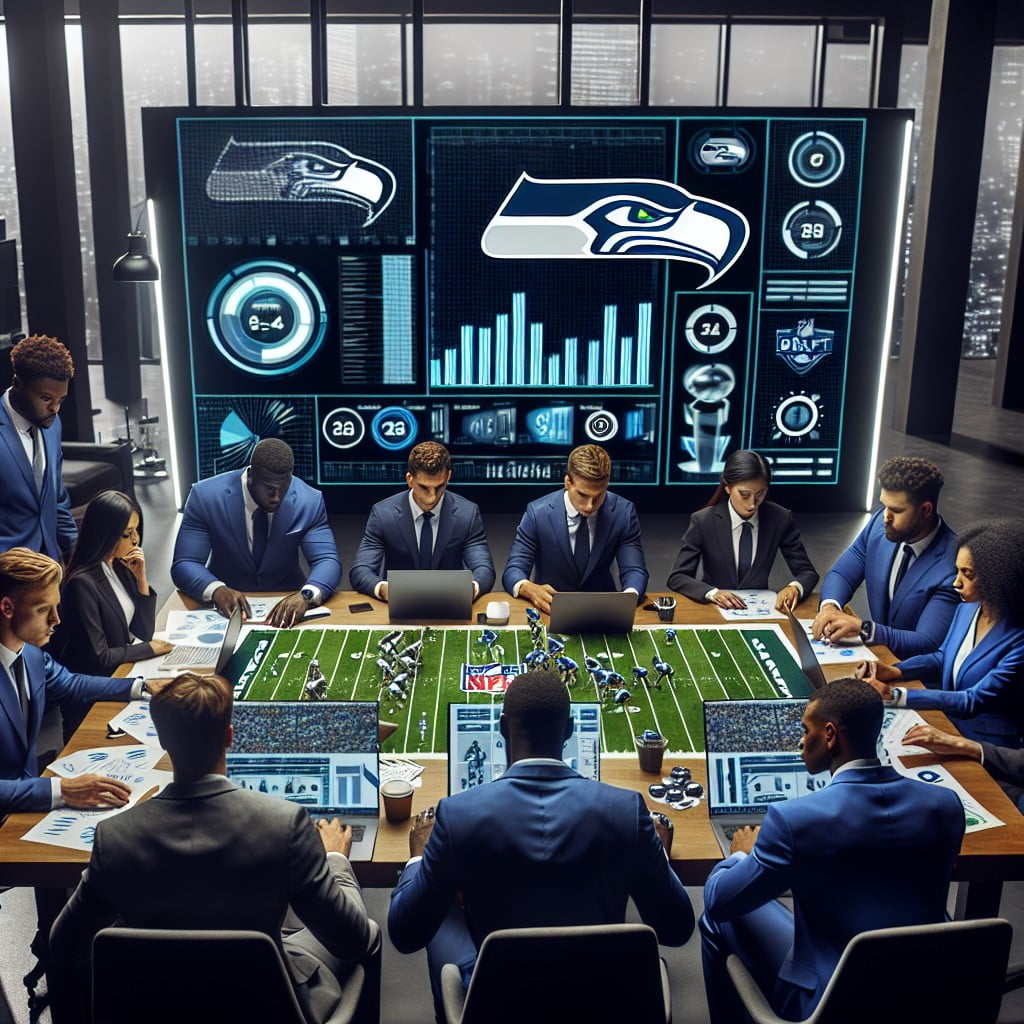Last updated on
Dive into the comprehensive analysis of the Seahawks draft, unraveling the reason for certain strategic pick-ups and passes because the key to any robust team lies within these crucial decisions.
As the NFL draft approaches, the Seattle Seahawks’ strategy is crystallizing, honing in on not just talent but the right fit for their distinctive playstyle.

Fans and pundits alike speculate on how the team will bolster their offensive line, add much-needed depth to their defense, and scout for players who can make an immediate impact.
Whether your interest lies in potential draft targets that align with the Seahawks’ intricate schemes or the possibility of strategic trades and under-the-radar sleepers, this deep dive into the Seahawks’ draft approach unveils how they might navigate their pressing team needs through savvy selection and calculated gambles.
Join us as we explore the prospects who could soon don the navy and green, ready to contribute on the gridiron and energize the special teams unit.
Key takeaways:
- Seahawks prioritize roster evaluation and scheme fit in draft strategy
- Team needs include offensive line, defensive depth, cornerback, and wide receiver
- Potential draft targets include offensive tackle, edge rusher, wide receiver, and cornerback
- Prospects must fit Seahawks’ offensive and defensive schemes and contribute on special teams
- Seahawks may consider trade scenarios, focus on sleeper picks, and be open to surprises
Seahawks Draft Strategy Overview
As the NFL Draft approaches, the Seattle Seahawks’ front office must prioritize assessing the roster’s needs to formulate a coherent strategy. In doing so, they typically consider several key factors:
- Current Roster Evaluation: Analyzing positions with depth concerns or aging players due for replacement.
- Scheme Fit: Identifying prospects whose skills align with the team’s offensive and defensive schemes.
- Draft Position: Adjusting the strategy based on the Seahawks’ draft order to anticipate which players may be available.
- Best Player Available vs. Need: Balancing the desire to pick the best talent on the board against filling a specific roster void.
- Long-Term Vision: Focusing on prospects who can contribute now yet offer potential for future development.
- Trade Potential: Remaining open to moving up or down in the draft to acquire additional picks or select a highly-rated player.
By integrating these elements into their draft blueprint, the Seahawks aim to secure a class of rookies capable of immediate impact and long-term success.
Evaluating Team Needs Post-Season
Post-season analysis highlights several areas where the Seahawks must enhance their roster. Firstly, the offensive line requires bolstering, especially at the center and guard positions to improve protection and run blocking.
Secondly, defensive depth is critical, with an emphasis on finding a dynamic edge rusher who can invigorate the pass rush.
Additionally, the secondary needs attention, particularly in acquiring a cornerback with lockdown capabilities.
Wide receiver depth could also see enrichment, ensuring reliable targets beyond the primary options.
Addressing these needs through the draft will help construct a balanced and competitive team for the upcoming season.
Potential Round-by-Round Draft Targets
Understanding the Seahawks’ selection strategy involves looking at suitable prospects across all seven rounds. In the early rounds, Seattle is expected to emphasize finding an immediate starter, focusing on positions like offensive tackle or edge rusher, areas of pressing need. Top-tier talent here can provide a cornerstone for the team’s future.
Middle rounds are typically about balancing best player available (BPA) with addressing depth chart requirements. Here, the front office might pivot towards a dynamic wide receiver to complement Metcalf and Lockett or infuse youth into the secondary with a versatile cornerback.
The late rounds are often where the scouting acumen is put to the test, mining for hidden gems who show great potential or exhibit strong football IQ and work ethic. These selections could include a developmental quarterback, a special teams standout, or a high-ceiling project at a less immediate position of need.
Each pick reflects a multi-layered strategy designed to create a competitive and balanced roster.
Assessing Draft Prospects’ Fit With Seahawks’ Schemes
When examining draft prospects for Seattle, it’s crucial to consider how their abilities sync with the team’s established offensive and defensive blueprints. Offensive coordinator Shane Waldron prizes versatility, meaning prospects who exhibit adaptability, especially in the wide receiver or running back positions, will be highly valued. For instance, a receiver who can effectively run a jet sweep or a running back adept at receptions could thrive in Waldron’s multifaceted offense.
On the defensive front, players must align with defensive coordinator Clint Hurtt’s preference for aggressive, physical play. Defensive ends and linebackers who demonstrate both speed and strength to pressure the quarterback fit the bill, given the Seahawks’ penchant for a pass rush that can collapse the pocket. Prospects also need to exhibit a strong defensive IQ to quickly read plays, a trademark of the Seahawks’ defense.
Moreover, Seattle’s special teams have often played a pivotal role in close games. Prospects with a track record of special teams contributions could offer value beyond their primary position, adding to the team’s overall competitive edge.
In summary, the prospects’ athletic prowess, football intelligence, and special teams experience are integral factors for the Seahawks when aligning player profiles with the team’s strategic philosophies.
Draft Trade Scenarios
Trade-up Possibilities:
- If a top-tier prospect starts slipping, the Seahawks may package lower-round picks or future selections to move up in the draft.
- Trading with teams looking to accumulate more picks could be an option if there’s a high-impact player Seattle is targeting.
Trade-down Scenarios:
- Seattle could leverage their high first-round pick to acquire additional second or third-round picks, especially in a deep draft class.
- Engaging teams with multiple late-round selections looking to get into a higher slot may yield beneficial returns for the Seahawks’ overall draft strategy.
Player-Involved Trades:
- In scenarios where roster depth or cap space is an issue, the Seahawks may consider trading away current players for draft capital.
- Trading for a veteran player from another team using draft picks can also be a strategy, particularly if there’s an immediate need at a specific position.
Lateral Moves:
- These involve trading picks of similar value with teams seeking specific prospects or looking to change their draft position for strategic reasons.
- Lateral trades can be a strategic fit if there’s a cluster of similarly graded players on the Seahawks’ board, minimizing risk while maintaining draft value.
Draft Sleeper Picks
Identifying sleeper picks in the draft can be a game-changer for teams seeking value beyond the early rounds. A sleeper is typically a player who flies under the radar—a prospect from a smaller school or someone whose potential has been overshadowed due to various reasons, such as injury or limited exposure.
For the Seahawks, scouting sleepers is an opportunity to outmaneuver competitors and bolster the roster without the premium cost of early-round picks. The key to uncovering these hidden gems lies in thorough scouting, analyzing player fit within the team’s system, and assessing intangibles such as work ethic and football IQ.
Here are several approaches the Seahawks may adopt when searching for sleeper picks:
- Prioritize versatility: Players capable of performing at multiple positions can be invaluable, offering depth to the team.
- Focus on senior standouts: Often overlooked, seasoned college players bring maturity and experience that can translate to immediate impact.
- Exploit small school talent: Lesser-known programs may harbor players with high ceilings who have developed outside the spotlight of big-time college football.
- Re-evaluate injured athletes: Those coming off injuries may fall in the draft, presenting a high-reward scenario if they can return to pre-injury form.
- Consider character: Athletes with strong leadership skills and high character may outperform their draft position, contributing positively to team culture.
By targeting such players, the Seahawks can add promising talent that might exceed their draft position’s expectations, enriching the team’s long-term prospects.
Impact of Seahawks Free Agency Moves On Draft Decisions
Free agency moves pave the way for drafting strategy by addressing immediate gaps and setting the stage for long-term roster development. If the Seahawks secure a high-profile wide receiver, for instance, they can deprioritize this position during the draft and focus on bolstering the defensive line or secondary. Conversely, failure to land a key free agent at a position of need, such as cornerback, may lead to a higher draft pick being used to fill that role.
Additionally, extensions for current players influence salary cap space, potentially altering draft dynamics. A starting lineman’s re-signing may mean the team is less likely to invest a top pick in that position, instead opting for depth in later rounds.
Successful free agency periods allow for a “best player available” approach in the draft, rather than reaching for necessity. This luxury can lead to higher quality picks with the potential for immediate impact. Hence, the Seahawks’ free agency activity sets a domino effect that significantly shapes their draft decisions, with the ultimate aim to create the most balanced and competitive team possible.
Seahawks Draft History Under Current Management
Since John Schneider took the helm as General Manager in 2010, the Seahawks have shaped their roster with a distinct draft philosophy:
1. Late-Round Value: Schneider’s ability to find starting-caliber talent in the later rounds is notable, with key players like Kam Chancellor and Richard Sherman originally drafted in the fifth and the sixth rounds, respectively.
2. Trading Down: Frequently trading down in the first round to accumulate more picks has been a staple tactic, allowing the Seahawks to broaden their talent acquisition efforts and gain better value.
3. Positional Focus: The front office has historically prioritized certain positions like defensive backs and linemen early in the draft, which has contributed to a strong defensive backbone.
4. Developmental Approach: The Seahawks have drafted athletes with high upside, focusing on their potential growth within the team’s system over immediate impact.
These strategies have culminated in foundational pieces for the Seahawks’ success over the past decade, including Super Bowl appearances and numerous playoff runs.
Comparing Seahawks’ Draft Needs to Division Rivals
Understanding how the Seahawks’ draft needs stack up against their NFC West counterparts provides insight into potential draft-day decisions. The division is known for its defensive prowess and innovative offenses, prompting Seattle to align its strategy accordingly.
Here are key points to consider:
- The Los Angeles Rams have recently focused on bolstering their offensive line through the draft, suggesting the Seahawks may also prioritize protecting their quarterback to remain competitive.
- San Francisco has invested heavily in receiving talent, thus highlighting the need for Seattle to reinforce its secondary to counteract this aerial threat.
- The Arizona Cardinals’ pursuit of versatile defenders may influence the Seahawks to seek similarly adaptable players to maintain defensive flexibility.
- Quarterback stability sets the Seahawks apart in the division. This advantage may shift draft priorities towards providing support for the established signal-caller with dynamic offensive weapons or reinforcing the offensive line.
- Lastly, observing the Rams’ and Cardinals’ focus on adding depth in the trenches could steer the Seahawks to fortify their own front lines on both sides of the ball to sustain the relentless divisional battles in the trenches.
Potential Seahawks Draft Day Surprises
The volatility of the NFL Draft often leads to unexpected turns, and Seattle has historically embraced such surprises. Here’s what to watch for:
- Positional Switch-Up: Anticipate the Seahawks to buck conventional wisdom by selecting a player in a position not widely regarded as an immediate need, reflecting their best-player-available philosophy.
- Unheralded Prospect Selection: Keep an eye on Seattle possibly drafting lesser-known prospects earlier than projected, showcasing their scouting department’s confidence.
- Draft Trades: Given their history, a trade up or down is always on the cards, particularly for accumulating more picks or snagging a coveted player who’s sliding.
- Last-Minute Dealings: Don’t be shocked by last-minute trades involving current players for draft capital, a maneuver that would shake up their draft dynamic.
The element of surprise remains a staple of the Seahawks’ draft approach, ensuring an unpredictable and thrilling Draft Day.
It’s Time to Focus On the Trenches, Not Linebacker and Safety
Prioritizing the offensive and defensive lines in the draft is essential for the Seahawks’ sustained success.
1. Protecting the quarterback: A robust offensive line is critical for QB development and efficiency. A fortified O-line can bolster the passing game and establish a more dynamic offensive strategy.
2. Enhancing the run game: Strong blockers pave the way for the rushing attack, allowing running backs to maximize yardage and control the game tempo.
3. Pressuring opposing quarterbacks: An effective defensive line disrupts the opposition’s offensive rhythm, leading to turnovers and mitigating their aerial assault.
4. Run defense: Solidifying the trenches aids in stifling opponents’ ground game, forcing one-dimensional offensive play and enhancing overall team defense.
By investing in linemen, the team can assert dominance at the line of scrimmage, which often dictates the outcome of games.
Brian’s Big Board for Seahawks 2023 Draft
Navigating the nuances of draft strategy, Brian’s Big Board zeroes in on a tailored approach for the Seahawks. Key considerations include:
- Addressing Value and Need: Preference is given to prospects who offer both immediate impact potential and align with the Seahawks’ most pressing roster vacancies.
- Versatility and Scheme Fit: Prospects are valued not only for their primary skill set but also for their adaptability to multiple positions or roles within the Seahawks’ existing schemes.
- Physical and Mental Makeup: Special attention is paid to players with the physical attributes and football IQ that match the team’s historical preferences.
- Upside Over Floor: The Big Board tends to favor players with higher ceilings who may require development over those who may be more NFL-ready but have limited growth potential.
- Long-Term Vision: While immediate needs are crucial, prospects that can grow with the team and offer future core talent are highlighted.
Each player on Brian’s list has been meticulously evaluated to ensure their fit within these criteria, setting the stage for a draft strategy that is as forward-thinking as it is grounded in the team’s current context.
Seahawks Roster Outlook (Defense): How to Upgrade Front Seven
The Seattle Seahawks face a pivotal task in fortifying their front seven, aiming to enhance both pass rush and run defense capabilities. The unit’s revitalization can be approached from multiple angles in the draft:
- Selection of a high-impact defensive lineman: Targeting a player who can immediately disrupt the line of scrimmage could be essential, with the priority on a defensive tackle who offers both size and agility or an edge rusher with a proven track record of quarterback pressures and sacks.
- Outside linebacker with versatility: Finding a linebacker capable of contributing to both the pass rush and coverage adds a dynamic element, encouraging adaptation to a variety of offensive schemes.
- Depth is crucial: Ensuring quality backups are secured in the middle-to-late rounds can create a strong rotational system, keeping the defensive front fresh and competitive.
- Focus on player development: Identifying prospects with raw talent but high ceilings allows the coaching staff the opportunity to mold them into key contributors, making for a long-term investment in the defense’s core strength.
By targeting these areas, the Seahawks can aim to construct a robust front seven poised to make significant strides in the upcoming season.
What Should the Seahawks Do At No. 9?
Holding the ninth overall pick yields substantial power for the Seahawks in terms of shaping their future roster. Here are key considerations:
Focus on Impact Players: The priority should be securing a player who can make an immediate impact. This often means looking at positions that can change the course of a game, such as a disruptive edge rusher, a lockdown cornerback, or a dynamic offensive tackle.
Draft for Value: Weighing the talent against the pick is crucial. If an elite prospect at a position of lesser need is available, the team should consider selecting the best player over reaching for need.
Explore Trade Opportunities: With high-value picks, the Seahawks could entertain trade offers. Moving down to accumulate additional picks might provide depth in a draft considered rich in talent at multiple positions.
Quarterback Question: If a top quarterback prospect falls to the ninth pick, the team faces a tough choice—draft the potential franchise QB or address another key position while considering quarterback options later in the draft or through other avenues.
Injury Rebounds: Players recovering from injury, if evaluated to return at full strength, might offer hidden value. Elite talent that slips due to short-term health concerns could provide long-term gains.
Immediate Starters: Given the high investment, selecting someone expected to start from day one is ideal. Ensuring the player can handle the pressure and demands of an NFL starting role is vital during the pre-draft evaluation process.
Senior Bowl Intel: What the League Is Saying About the Seahawks
Industry buzz from Senior Bowl week often provides valuable insights into a team’s draft strategy. Conversations with scouts, coaches, and executives have hinted at the Seahawks’ interest in bolstering their defensive line, given the rich talent available in this year’s draft class. Notably, there’s talk about the Seahawks doing extensive homework on pass rushers, a move indicating a possible focus on enhancing their pass defense.
Additionally, the Seahawks’ presence at quarterback workouts, despite not conducting them personally, suggests they’re keeping an option open to draft a signal-caller should the right opportunity present itself. However, the consensus among league insiders is that Seattle’s primary concern is building in the trenches, with less chatter about searching for secondary help, seemingly confident in their young defensive backs’ development.
The Case for Drafting a Quarterback
Understanding the necessity for a franchise quarterback is paramount for any NFL team aiming for long-term success. The Seahawks’ pursuit could very well hinge on this draft for the following reasons:
1. Age and Durability: With the current roster’s quarterbacks advancing in age and having a history of injuries, securing a young and resilient signal-caller is essential for sustained performance and durability.
2. Long-Term Investment: Dedicating a high draft pick to a quarterback can be a strategic move, offering the team a potential cornerstone player around whom to build for the future.
3. Salary Cap Management: A rookie quarterback on a first contract significantly aids in salary cap management, allowing the allocation of financial resources to bolster other positions.
4. Offensive Evolution: The offensive scheme’s evolution necessitates a quarterback with the skill set to execute modern NFL offenses effectively and add a new dimension to the team’s playbook.
5. Competition and Depth: Drafting a quarterback creates healthy competition, ensuring the team is not complacent and always has depth at the game’s most critical position.
John Schneider Draft History & Tendencies
John Schneider, the General Manager for the Seattle Seahawks, is renowned for his unorthodox approach to the NFL Draft, often valuing versatility and upside over conventional wisdom.
Here are some key points reflecting his draft tendencies and history:
- Trade Maneuvers: Schneider frequently trades down to accumulate more picks, favoring quantity to increase the odds of finding quality players.
- Athletic Profiles: Prospects with exceptional physical traits, particularly those with high SPARQ (Speed, Power, Agility, Reaction, and Quickness) scores, often catch Schneider’s eye.
- Defensive Preference: Historically, Schneider has a preference for defensive players in the early rounds, particularly those who can bolster the pass rush or secondary.
- Late-Round Gems: Schneider has a reputation for unearthing talent in the later rounds, with notable successes like Richard Sherman and Kam Chancellor.
- Developmental Quarterbacks: In the mid to late rounds, Schneider has shown a propensity for selecting quarterbacks with developmental potential, acknowledging the importance of depth at the position.
- Offensive Linemen with Upside: Offensive linemen drafted by Schneider often have unique physical attributes or noteworthy upside rather than polished technique.
- Undervalued Prospects: Schneider is willing to draft players who may have been overlooked or undervalued due to injuries or off-field issues, betting on their potential return on investment.
Understanding these characteristics helps paint a picture of potential moves the Seahawks might make under Schneider’s direction in the upcoming draft.
Recap:




